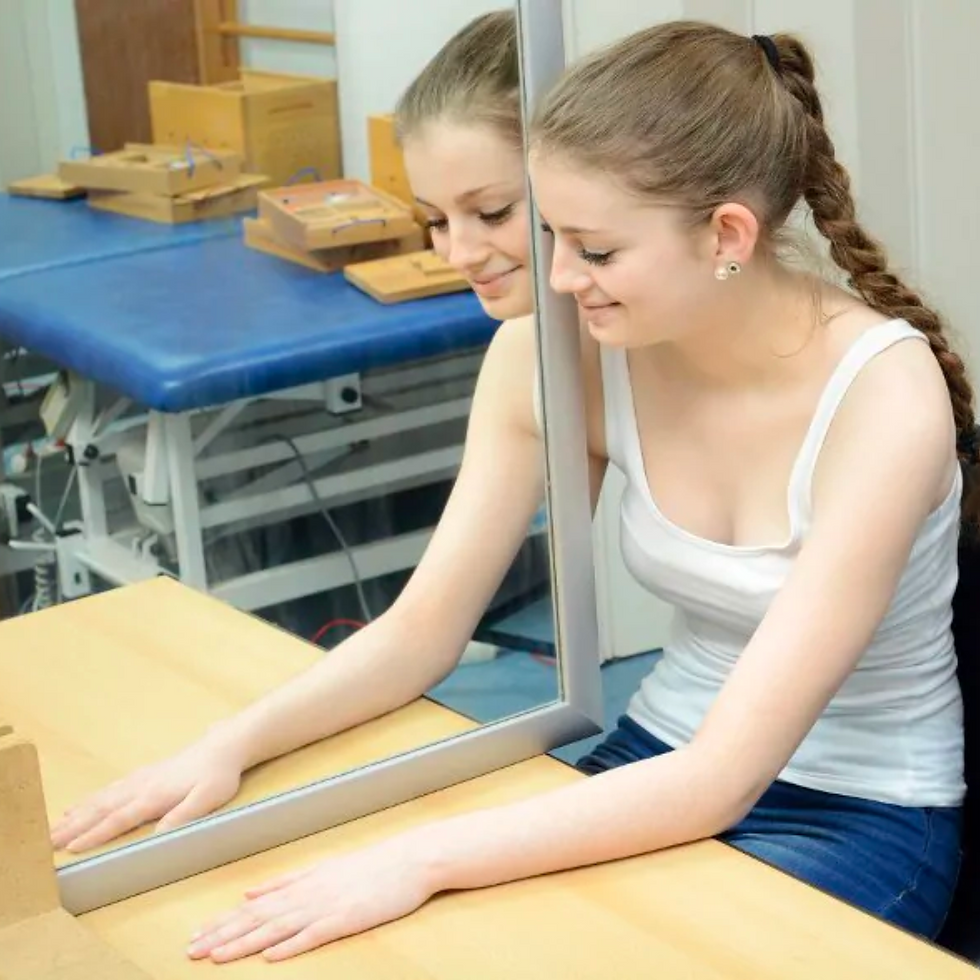Everything You Need to Know About Mirror Therapy
- Bankstown Physiotherapy
- May 4, 2024
- 2 min read
Medical Practices are always changing and innovative therapies continually emerge, offering new hope and avenues for recovery. Among these, Mirror Therapy stands out as a groundbreaking intervention with profound implications for individuals grappling with a spectrum of physical challenges, from neurological impairments to musculoskeletal injuries and chronic pain conditions.
At Bankstown Physiotherapy & Sports Injury Centre, we'll help you understand everything you need to know about Mirror Therapy, exposing its mechanisms, exploring its applications, and highlighting its transformative potential.
The Mechanisms Underlying Mirror Therapy
Mirror Therapy operates on the fundamental principles of neuroplasticity and visual feedback. At its core lies the concept of cortical reorganization—the brain's remarkable ability to adapt and rewire itself in response to sensory input and experience. When an individual experiences injury, illness, or chronic pain, disruptions occur within the intricate neural networks governing motor function and sensory perception. Mirror Therapy harnesses the power of visual illusions to recalibrate these neural pathways, eliciting profound changes in motor control, pain perception, and functional ability.

How Mirror Therapy Works in Practice
The implementation of Mirror Therapy is elegantly simple yet conceptually profound. Patients are positioned in front of a mirror, strategically placed to reflect the unaffected limb or body part, creating the illusion of symmetrical movement. As the individual engages in motor tasks or exercises with the unaffected limb, the mirror provides visual feedback that simulates movement in the affected limb. This visual input contradicts the brain's existing perception of the impaired limb, prompting a reevaluation of neural signaling and facilitating motor relearning and recovery.
The Therapeutic Benefits of Mirror Therapy
The therapeutic benefits of Mirror Therapy are wide-ranging and encompass diverse clinical presentations:
Pain Modulation: Mirror Therapy has demonstrated remarkable efficacy in modulating pain perception, particularly in conditions such as phantom limb pain, complex regional pain syndrome (CRPS), and musculoskeletal pain syndromes. By engaging in mirror-guided movements, patients experience a reduction in pain intensity and frequency, attributed to the recalibration of nociceptive processing pathways within the central nervous system.
Motor Rehabilitation: Mirror Therapy serves as a cornerstone intervention for promoting motor recovery and functional independence. Stroke survivors, individuals with traumatic brain injury, and those with peripheral nerve injuries benefit from mirror-induced neuroplastic changes, which enhance motor control, coordination, and proprioceptive awareness.
Psychological Well-being: Beyond its physical effects, Mirror Therapy exerts a profound impact on patients' psychological well-being, fostering a sense of agency, empowerment, and hope. The restoration of motor function and the alleviation of pain contribute to enhanced self-esteem, reduced anxiety, and improved quality of life—a testament to the holistic nature of rehabilitation medicine.
Final Thoughts
At Bankstown Physiotherapy & Sports Injury Centre, we are committed to pushing the boundaries of rehabilitation medicine and embracing cutting-edge therapies that optimize patient outcomes. Our team of skilled physiotherapists integrates Mirror Therapy into comprehensive treatment plans tailored to each individual's unique needs and goals. Whether you're navigating the complexities of neurological rehabilitation, recovering from orthopedic surgery, or seeking relief from chronic pain, Mirror Therapy offers a beacon of hope and healing on your journey toward recovery.

Comments